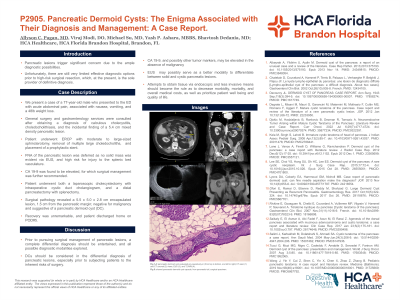Tuesday Poster Session
Category: Biliary/Pancreas
P2905 - Pancreatic Dermoid Cysts: The Enigma Associated with Their Diagnosis and Management: A Case Report
Tuesday, October 24, 2023
10:30 AM - 4:00 PM PT
Location: Exhibit Hall

Has Audio

Allyson C. Pagan, MD
HCA West Florida Brandon
Brandon, FL
Presenting Author(s)
Allyson Pagan, MD1, Viraj Modi, DO2, Michael Su, MD3, Yash P. Ashara, MBBS4, Bhavtosh Dedania, MD5
1HCA West Florida Brandon, Brandon, FL; 2HCA Healthcare, Brandon, FL; 3HCA West Florida, Brandon, FL; 4Mayo Clinic, Rochester, MN; 5HCA Florida Brandon Hospital, Brandon, FL
Introduction: Dermoid cysts (DCs) are mature cystic teratomas, which usually follow a benign course. When found in the pancreas, lesions trigger significant concern due to the ample diagnostic possibilities. Unfortunately, there are still very limited effective diagnostic options prior to high-risk surgical management, which solely provide definitive diagnosis.
Case Description/Methods: We present a case of a 77-year-old male with atrial fibrillation, non-ischemic cardiomyopathy, chronic kidney disease stage 3, and obesity, who presented to the ED with acute abdominal pain, associated with nausea, vomiting, and a 48lb weight loss. Labs were significant for mild leukocytosis and hyperbilirubinemia of 4.5mg/dL. Patient was diagnosed with cholelithiasis, cholecystitis, and choledocholithiasis, admitted, and both general surgery and gastroenterology services consulted. During initial imaging studies, an incidental 5.4cm mixed density pancreatic lesion and numerous left kidney cysts were also found. Patient underwent ERCP with moderate to large-sized sphincterotomy, removal of multiple large choledocholiths, and placement of a prophylactic stent. FNA of the pancreatic lesion was limited due to body habitus, no appreciation of a solid mass via EUS, and the cyst's close proximity to the vascular splenic bed. CA 19-9 was found to be elevated, for which surgical management was further recommended. After obtaining risk stratification from cardiology service, who deemed patient at a high, but not prohibited surgical risk, patient underwent both laparoscopic cholecystectomy with intraoperative cystic duct cholangiogram, as well as distal pancreatectomy with splenectomy. Surgical pathology revealed a 5.5 x 5.0 x 2.8cm encapsulated lesion, 1.5cm from the pancreatic margin; negative for malignancy and suggestive of a pancreatic DC. Recovery was unremarkable, and patient discharged home on POD5.
Discussion: Invasive surgical management continues to be the overall recommendation for pancreatic DCs; although no report exist of malignant transformation [1]. With our case, we re-emphasize how CA 19-9, and possibly other tumor markers, may be elevated in the absence of malignancy, how EUS possibly serves as a better modality to differentiate between solid and cystic pancreatic lesions, and how these entities should be considered in the differential diagnosis prior to subjecting our patients to the inherent risks of surgery, which include death, as reported in a case of a 20-year-old male from Turkey [2].
Disclosures:
Allyson Pagan, MD1, Viraj Modi, DO2, Michael Su, MD3, Yash P. Ashara, MBBS4, Bhavtosh Dedania, MD5. P2905 - Pancreatic Dermoid Cysts: The Enigma Associated with Their Diagnosis and Management: A Case Report, ACG 2023 Annual Scientific Meeting Abstracts. Vancouver, BC, Canada: American College of Gastroenterology.
1HCA West Florida Brandon, Brandon, FL; 2HCA Healthcare, Brandon, FL; 3HCA West Florida, Brandon, FL; 4Mayo Clinic, Rochester, MN; 5HCA Florida Brandon Hospital, Brandon, FL
Introduction: Dermoid cysts (DCs) are mature cystic teratomas, which usually follow a benign course. When found in the pancreas, lesions trigger significant concern due to the ample diagnostic possibilities. Unfortunately, there are still very limited effective diagnostic options prior to high-risk surgical management, which solely provide definitive diagnosis.
Case Description/Methods: We present a case of a 77-year-old male with atrial fibrillation, non-ischemic cardiomyopathy, chronic kidney disease stage 3, and obesity, who presented to the ED with acute abdominal pain, associated with nausea, vomiting, and a 48lb weight loss. Labs were significant for mild leukocytosis and hyperbilirubinemia of 4.5mg/dL. Patient was diagnosed with cholelithiasis, cholecystitis, and choledocholithiasis, admitted, and both general surgery and gastroenterology services consulted. During initial imaging studies, an incidental 5.4cm mixed density pancreatic lesion and numerous left kidney cysts were also found. Patient underwent ERCP with moderate to large-sized sphincterotomy, removal of multiple large choledocholiths, and placement of a prophylactic stent. FNA of the pancreatic lesion was limited due to body habitus, no appreciation of a solid mass via EUS, and the cyst's close proximity to the vascular splenic bed. CA 19-9 was found to be elevated, for which surgical management was further recommended. After obtaining risk stratification from cardiology service, who deemed patient at a high, but not prohibited surgical risk, patient underwent both laparoscopic cholecystectomy with intraoperative cystic duct cholangiogram, as well as distal pancreatectomy with splenectomy. Surgical pathology revealed a 5.5 x 5.0 x 2.8cm encapsulated lesion, 1.5cm from the pancreatic margin; negative for malignancy and suggestive of a pancreatic DC. Recovery was unremarkable, and patient discharged home on POD5.
Discussion: Invasive surgical management continues to be the overall recommendation for pancreatic DCs; although no report exist of malignant transformation [1]. With our case, we re-emphasize how CA 19-9, and possibly other tumor markers, may be elevated in the absence of malignancy, how EUS possibly serves as a better modality to differentiate between solid and cystic pancreatic lesions, and how these entities should be considered in the differential diagnosis prior to subjecting our patients to the inherent risks of surgery, which include death, as reported in a case of a 20-year-old male from Turkey [2].
Disclosures:
Allyson Pagan indicated no relevant financial relationships.
Viraj Modi indicated no relevant financial relationships.
Michael Su indicated no relevant financial relationships.
Yash Ashara indicated no relevant financial relationships.
Bhavtosh Dedania indicated no relevant financial relationships.
Allyson Pagan, MD1, Viraj Modi, DO2, Michael Su, MD3, Yash P. Ashara, MBBS4, Bhavtosh Dedania, MD5. P2905 - Pancreatic Dermoid Cysts: The Enigma Associated with Their Diagnosis and Management: A Case Report, ACG 2023 Annual Scientific Meeting Abstracts. Vancouver, BC, Canada: American College of Gastroenterology.
